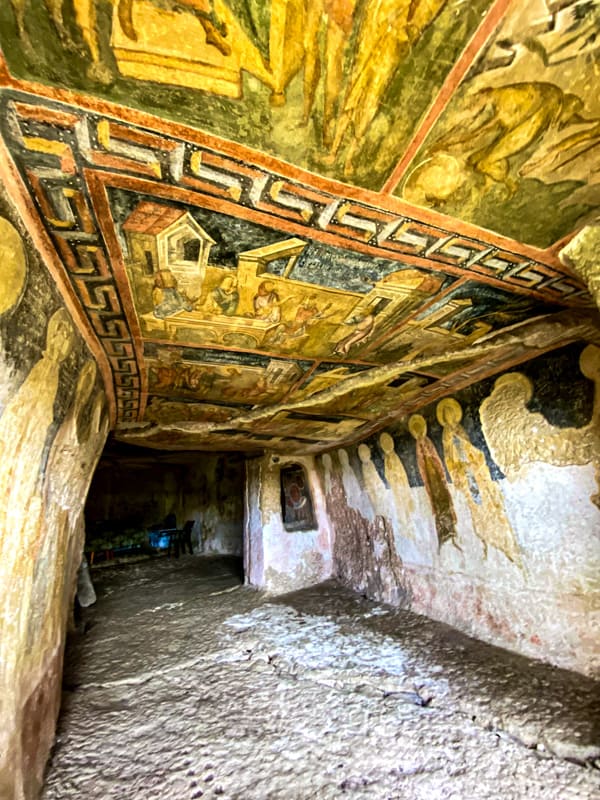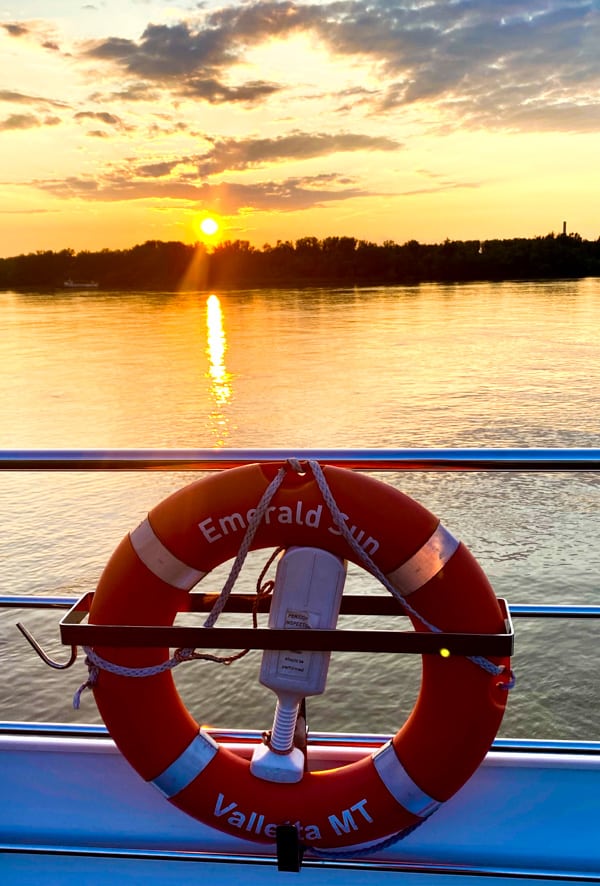When most people picture a European river cruise they envision fairytale castles, impressive capital cities, quaint towns and villages and riverbanks covered with vineyards. And this is exactly what you get on the most popular cruises along the Upper Danube, Rhine, Main and Moselle rivers.
We feel blessed to have enjoyed several of these dreamy European river cruises over the years and have hundreds of gorgeous postcard-worthy photos of those castles, cities and landscapes. You can read about our Emerald River cruise review here. But last month we had a whole new experience when we set sail on The Emerald Eastern European river cruise along the lower Danube.
- Was It What We Expected?
- How Is an Eastern Europe River Cruise Different?
- What Will You Get on an Emerald Eastern Europe River Cruise?
- 1. Lesser-Traveled Destinations
- 2. Stunning Cities
- 3. Education
- 4. Authentic Experiences
- 5. Real People With Real Stories
- 6. Layers of History
- 7. Natural Wonders
- 8. Man-Made Wonders
- Is An Eastern European River Cruise Right For You?
Was It What We Expected?
Emerald’s Enchantment of Eastern Europe itinerary sails through five countries over eight nights and nine days. Guests spend the first night in a hotel before boarding one of Emeralds’ handsome Star Ships for seven nights. Our June cruise began in Bucharest, Romania and ended in Budapest, Hungary with stops along the way in Bulgaria, Serbia and Croatia.
Although not extensively, we have visited each of these five countries, so we knew it would be quite a different experience than sailing through Austria, Germany and the Netherlands. However, we were not fully prepared for how much we would learn and how moved we would be by the stories we heard and the people we met.
How Is an Eastern Europe River Cruise Different?
The scenery along the lower Danube River is not as consistently beautiful as the upper Danube, but it’s still worthy of hundreds of gorgeous photos and hours of viewing on the sundeck. There are more coach transfers for excursions on the lower Danube as the places of interest are not all accessible from the riverbanks.
Only two locks are navigated on the lower Danube as opposed to 18 or more locks on the upper. The destinations on the lower Danube are lesser-visited and therefore less crowded and less expensive.
But, in our opinion, the biggest difference is the feeling of having had an authentic experience learning about the people, the places and the history of the countries you visit. There is still a rawness to these countries. And the challenges they have faced, and are still facing, are in plain sight. But there is also a sense of hope and determination to rebuild their towns, and their lives, that had us wanting to cheer them on in support.
This feeling extended to our time on board as many of Emerald’s staff are from Eastern Europe. When asked, they were happy to share their own stories, memories and favorite places from their home country which added to the overall experience.
What Will You Get on an Emerald Eastern Europe River Cruise?
We’ve told you a bit about what to expect on a lower Danube river cruise but here are eight things that we found to be highlights of our Emerald Enchantment of Eastern Europe experience.
1. Lesser-Traveled Destinations
A cruise on the upper Danube will take you to famous and popular tourist spots like Regensburg, Vienna and Salzburg. Whereas a lower Danube River cruise will have you visiting countries and destinations that are off the beaten path and therefore provide a more authentic experience without all the tourist polish.
Some of the lesser-known places that were highlights of this river cruise included the elegant city of Ruse (Rousse), which is also referred to as Little Vienna, and the wine region of Vidin, both in Bulgaria. We also enjoyed Serbia’s capital city of Belgrade and the historic university town of Vukovar, Croatia.
We always choose to visit Europe in the shoulder or off-season (September-May) to avoid the crowds of high-season (June-Aug). One of the perks of a river cruise through Eastern Europe is that you can go in the summer months and enjoy the warm weather without as many tourists.
In general, Eastern European countries are far behind Western Europe when it comes to tourism, but they are working hard to show the world what they have to offer. This means that visitors are eagerly welcomed and prices are generally lower than in Western Europe.
In addition, there is the opportunity to contribute to an emerging country where family-run and small businesses still have a chance against chain stores and mass tourist shops.
2. Stunning Cities
Whichever direction you choose to sail, Emerald’s Eastern Europe river cruise begins and ends with two beautiful capital cities; Bucharest and Budapest. Interestingly, it seems that both impressive cities have been nicknamed “Paris of the East.”
With the incredible architecture of buildings like the Hungarian Parliament, Buda Castle and St Stephen’s Basilica, Budapest’s beauty is instantly obvious, especially along the riverfront. And that’s just the beginning.
All throughout the city there is an array of architectural styles including Baroque, Gothic, Art Nouveau, Romanesque and Neoclassical. Budapest is also a very lively city with vibrant nightlife, international dining and plenty of shopping.
Tip: If you choose to go from Bucharest to Budapest you will be treated to the awesome vision of sailing into Budapest which is a sight you will never forget…except for the dozens of photos you took. Plus, if you’re lucky (as we were) Emerald will spoil you with a nighttime cruise to view the stunning buildings along the river all lit up.
You must dig a little deeper to find Bucharest’s beauty but once you step into Old Town it’s all on display. The architecture here is diverse with styles old and new vying for attention.
Some of Bucharest’s landmarks include the massive Palace of Parliament, the Gothic Revival Caru’ cu Bere (beer wagon), Stavropoleos Monastery and the Romanian Athenaeum. The “Paris of the East” nickname likely came from the wide boulevards and the Arcul de Triumf.
3. Education
Emerald’s Enchantment of Eastern Europe cruise on the Lower Danube was the most thought-provoking and educational cruise we’ve yet taken. Like our previous river cruises, we were pampered and spoiled with a spacious and comfortable suite, delicious food and attentive staff.
However, this river cruise was much more than beautiful landscapes, historic castles, wine tastings and fun entertainment and activities.
Our cruise took us through five post-communist countries that are working hard to shed their turbulent past and make their own way. The mix of beautiful, old architecture that survived many attacks and Soviet-era, grey concrete blocks that are now abandoned or hiding unexpectedly homey apartments showcases the conflicts of the not-too-distant past.
One example of our educational experience was the Emerald Excursion in Bucharest where we visited the Spring Palace. This extravagant and luxurious residence was once home to communist dictator Nicolae Ceausescu and his wife Elena.
As we toured the 80-plus, lavishly (and somewhat gaudily) decorated rooms we learned about the reign of Romania’s communist leader from 1965 to 1989.
The rooms were full of the original lavish furniture, Murano glass chandeliers, Indian silk carpets, intricate tapestries and walls of murals made of thousands of mosaics. The palace also contains the extravagant “Golden Bathroom”, an indoor pool, a spa, a theater room, an elaborate British-style greenhouse and even a bunker for the family to hide in case of a revolution.
Viewing all this opulence while picturing the bleak and dreary homes and lives of the Romanian people at that time was moving and eye-opening.
4. Authentic Experiences
Although most of the excursions with Emerald River Cruises are included, they do offer a few “Discover MORE” options at an additional cost. When we saw the option for a cooking class in Vidin, Bulgaria we jumped at it.
A small group of us were taken to the home and small farm of Lyubo and Niki, a lovely couple who have taken to growing much of their own food and hosting cooking classes in their retirement.
We were greeted with a taste of their homemade Rakia (Bulgarian moonshine) and herbal tea while getting comfortable in their kitchen. The dish we were to learn to make is called “banitsa.” It’s a traditional pastry made from phyllo that is loved in every Bulgarian household and is always made on special occasions.
At Christmas and NYE, kusmet (lucky charms, usually small pieces of a Dogwood branch) are hidden in the banista and recipients are granted wishes.
After a demonstration, we were all able to try our hand at preparing and baking this delicious treat and then of course we devoured the finished product. It was a fun, educational and delicious afternoon.
5. Real People With Real Stories
Our stop in Croatia took us to Osijek and the town of Vukovar, a town that was nearly destroyed during the Yugoslav War. We were split into small groups and hosted by a local family for lunch on an “Emerald PLUS” excursion.
Initially, we anticipated the highlight to be an authentic, home-cooked Croatian meal, but it turned out that the food took second place to talking with our host.
The lovely lady that hosted us was welcoming and very open about her experience during the breakup of Yugoslavia and the ensuing war. She was a young mother at the time and while most of Vukovar’s population had been forced to flee, she and her two children were separated from her husband and left behind. Somehow, they managed to survive for months in the ruins of their bombed home before being rescued.
While there are different sides and many differing stories and opinions regarding this bloody war, it was heartbreaking to hear of her suffering. It was also eye-opening to remember that these atrocities occurred just 30 years ago.
Although this was not the most lighthearted experience, we did also share laughs and happy memories and parted ways with increased insight into what happened to people in Eastern Europe during and after life behind the Iron Curtain.
6. Layers of History
Eastern Europe offers history buffs plenty to keep them occupied. However, we were surprised to find one of the largest and most significant Stone Age prehistoric archeological sites in the world right in Serbia. The Lepenski Vir Archaeological Site and Museum displays findings of a culture that lived on the banks of the Danube more than six thousand years ago.
Excavations of the site were done between 1965 and 1970 when seven layers of successive settlements spanning 9500 BC to 6000 BC were uncovered. Remains of more than 130 buildings were discovered along with stone altars, tools, pottery, statues, jewelry and skeletal remains.
Everything was painstakingly moved from the shore to the current museum site and is now beautifully displayed. Visitors can also watch a short but very interesting film documenting Professor Dragoslav Srejović and his team as they unearthed this amazing discovery.
7. Natural Wonders
On the day our ship brought us to Vidin, Bulgaria, we opted for the “Emerald ACTIVE” excursion which was a hike at Belogradchik Fortress. This former Roman stronghold was first built in the 3rd century AD and was used for centuries by numerous leaders and conquerors although it had to be rebuilt and fortified several times.
However, it’s the natural wonder of the site that wowed us. The Romans chose the location as a stronghold spot because the unique rock formations created a natural protective, impenetrable barrier on three sides. These massive rock formations rise 250 to 650 meters and were formed millions of years ago when the area was a shallow sea.
Climbing the stairs of the fortress takes you to stunning viewpoints where on a clear day it feels like you can see forever. You also get up close to the cool monolithic rock formations for some amazing photos.
8. Man-Made Wonders
We chose to join another Emerald ACTIVE excursion in Bulgaria to the UNESCO World Heritage-listed Rock-Hewn Churches of Ivanovo. This area of Northeastern Bulgaria was inhabited by monks for hundreds of years and is a testament to the strength of human faith and perseverance.
Monks first began living in these caves in the 12th century and by the end of the 14th century, there was an extensive complex of cells, monasteries, churches and chapels carved into the rocks. Only a few remain for viewing today.
As impressive as the remaining rock-hewn churches are in themselves, the most amazing sight is the beautiful 14th-century frescoes created by the artists of the Tarnovo School of Painting. It’s incredible to see the skill of these artists still so well-preserved hundreds of years later.
Is An Eastern European River Cruise Right For You?
So, what do you think? Is this an experience you would enjoy? We would say that if you’re a history buff, especially recent history, this cruise is definitely for you.
Also, if you have Eastern European heritage it will be a special trip. We spoke with a few people on board who were following their family lines or who were actually living in Eastern Europe during the communist years and wanted to re-visit.
Finally, if you’re an avid river cruiser and have done all the more popular routes in Europe this itinerary will provide you with something different to add to your cruising repertoire. We believe that travel can be so much more than an escape from your day to day.
Travel can educate, help us to grow, and open our hearts and minds to the beautiful diversity of the world and the people that live in it. Emerald’s Enchantment of Eastern Europe River Cruise is a perfect example of experiential and meaningful travel.

Born in England, Sarah developed her wanderlust at a young age as she traveled around Europe with her parents. As a young adult she spent every penny she could on experiences as opposed to possessions. Eventually she found a way to earn a living doing what she loved: traveling, writing and capturing images of the wondrous world we live in. When not on the go Sarah enjoys time in her “sometimes home” of Vancouver.












